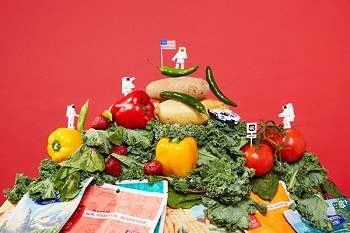As the race to the red planet heats up NASA hopes to send humans to Mars by the 2030s, and a private rocket venture, SpaceX, is aiming for sooner scientists are working on building a garden in space. The goal is to grow fresh produce to supplement existing packaged foods.
NASA has already harvested a variety of edible leafy greens, grown without earthly gravity or natural light. Soon, researchers plan to expand to a more difficult crop, in their quest to answer one of the most pressing questions of a Mars mission: How will astronauts get enough nutritious food to survive years in the unforgiving depths of space?
Scientists believe the project, if successful, could open the door to growing similar crops in space think tomato plants and strawberries and perhaps eventually to more advanced foods, like potatoes.
“This is the most complex crop we have done to date for food purposes,” said Scientists , who are leading the pepper experiment for NASA.
The peppers are being tested on Earth, they said, and could be sent to space as early as next spring.
Scott Kelly, a retired astronaut who set an American record in 2016 when he returned after spending 340 days in space, said he received a shipment of fresh fruit and vegetables every few months while on the International Space Station. But that would not be possible on a trip to Mars.
“It’s not like you can just run out to the store,” he said. “To have fresh food, it helps with nutrition. It also helps with morale.”
50 years of space food: from ‘moisture bite’ brownies to blueberry crumble
The first moon landing took place in the “tube and cube days” of space food, when a typical menu included items like peanut cubes, turkey and gravy wet packs and brownies that were described as an “intermediate moisture bite.”
The beverage Tang also had a long association with spaceflight. Many people mistakenly believe NASA invented it.
Today, about 200 food and drink items are available on the International Space Station, according to NASA spokeswoman.
The food, which is much like camping food and has to be reheated or rehydrated with water, ranges from your basics, like cereal and eggs, to more complex dishes like chicken fajitas, macaroni and cheese and blueberry crumble. “Shrimp cocktail is a longtime popular dish,” they said.
While scientists use the space station as a test kitchen for long-term space travel, there is another necessity to consider: water.
The station uses a sophisticated water recycling system, which collects humidity, sweat and even urine and turns it into drinking water.
Nasa said the system would need to be smaller and to work more reliably on a mission to Mars, because there would be no option to send shipments of water from Earth. But the same ethos would hold true: “Yesterday’s coffee,” she said, “is tomorrow’s coffee.”
Lettuce, peppers and a garden in space
No matter how many options there are, packaged food alone would not be enough to fuel a mission to Mars.
Certain vitamins break down over time, leaving astronauts at risk of inadequate nutrition.
Scientists have experimented with growing plants on board the International Space Station for years. The Russians grew peas in the early 2000s, for example. More recently, NASA harvested red romaine lettuce, which had been nurtured under the purplish, LED lighting of a special vegetable garden known simply as “Veggie.”
For a tasting in 2015, astronauts used extra virgin olive oil and balsamic vinegar to dress the leaves. “Kind of like arugula,” Mr. Kelly said at the time.
NASA has since grown other types of leafy greens, including Chinese cabbage and mizuna mustard.
The Española improved chile, a durable pepper native to New Mexico, represents the next frontier.
The peppers are, in many ways, the perfect test case: They are more difficult to grow than lettuces. They are a good source of vitamin C. And they pack a punch in spice, great for astronauts who have reduced senses of smell and taste in space.
Preparing for Mars
If this space gardening plan works, scientists say, it could help combat “menu fatigue” among astronauts, who typically lose weight while spending months in space.
Maintaining a garden could also serve as a hobby for crew members during monotonous months. “It’s kind of like, why do people like flowers?” Mr. Kelly said. “When you are living in an environment that is very antiseptic or laboratory-like, or on Mars, it would be pretty devoid of life with the exception of you and your crewmates. Having something growing would have a positive psychological effect.”
And it could also help the crew become more autonomous, in case something goes wrong.
Lara Khouli.

